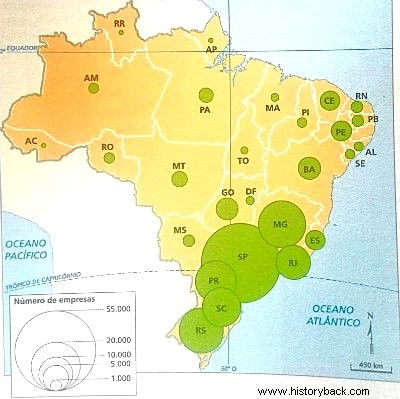Industry it is the concentration of productive activities destined to transform raw material into goods for the most different consumptions.
Its importance is so great nowadays that almost everything we consume and use is processed or produced by the industry.
Industry Evolution
The historical evolution of the industry can be recognized in three stages:craftsmanship, manufacture and machine-making.
Crafts – stage in which the producer (artisan) alone performs all stages of production and even the marketing of the product. The artisanal way of producing prevailed until around the 17th century, but it can still be found in several countries around the world.
Manufacture – at this stage, there was already a division of labor, where each worker performed a task or was responsible for part of the production. Although simple machines were already used, production depended fundamentally on manual work.
The stage of manufacture corresponds, in general, to the transformation of the artisan into a wage-earner. Manufacture characterized the initial phase of capitalism, in the 17th and mid-18th centuries.
Although the term manufacture corresponds to the second stage of the industry's evolution, it is also used to designate industrialized (manufactured) products.
Machinofacture – is the process started in the 18th century with the Industrial Revolution. It is characterized by the massive use of machines and energy sources such as coal and oil, large-scale production, large division and specialization of work.
During the First Industrial Revolution, mechanization spread from textiles to metallurgy and factories employed large numbers of workers.
From the end of the 19th century, a period known as the Second Industrial Revolution, with the use of new technologies, the whole world began to buy and use industrialized products manufactured in large centers.
During this period, large industries had branches in several countries, multinationals or transnationals.
In the middle of the 20th century, after the two great wars, the capitalist world reorganized itself. The mobility of companies, capital and the technological revolution accentuated the internationalization of the economy.
The great industries started to incorporate modern technologies, starting the phase of the Third Industrial Revolution and also of Globalization.
Read more in Fordism and Taylorism.
Industry 4.0
The world industry is undergoing a process of change as marked as the Industrial Revolution. This set of transformations is conventionally called 4.0 in reference to the power of the engines.
Industry 4.0 is characterized by joining three factors to its production line:technological progress, digitalization and innovation.
1
Industrial automation reduces production costs and increases product quality. Software that integrates production lines is creating smart factories. Through sensors, machinery and product exchange information during the manufacturing process.
The automobile industry is among the most robotic in the world:robots with their mechanized arms do everything from the manufacturing process to the final quality tests. Employees, few in number, follow everything through their computer screens.

2 . The immense amount of digital information available in some segments. Product conception, testing with new materials, with new parts, design, factory architecture, production line organization, material inventory, everything is digital.
In fact, 3D virtual technology is already being used to test new products.
See also:Information Society3 . Advances in the area of innovation is another great tool for industries that can recombine existing technologies and make contributions in the area of design, new materials, management and production.
In just 15 years, computers and the internet have already revolutionized industries. Although it is a worldwide phenomenon, it is more present in the United States, Japan and Europe.
This technological evolution eliminates jobs and skilled labor is increasingly in demand.
Brazilian Industry
An industrialized country, in addition to offering jobs, can meet many of its domestic consumption needs, reduce its imports and increase exports.
In this way, Brazil seeks to favor industrial activity, despite economic and regional disparities. Below we can see the spatial distribution of industries in the national territory.

According to data from the Industry Portal, from 2017, the Brazilian industry contributes R$ 1.2 trillion to the Brazilian economy per year. This means that 22% of the Brazilian GDP comes from industrial activities.
However, the growth of Brazilian industry is hampered by the lack of skilled labor and, especially, by the tax burden. Therefore, the capacity of the Brazilian industrial park ends up working below what would be possible.
Read Also :
- Types of Industries
- Industrialization in Brazil
- Industrial Society
- Cultural Industry
- Toyotism
- Sectors of the Economy
